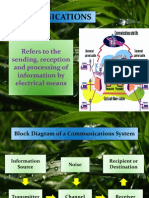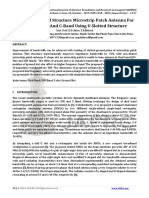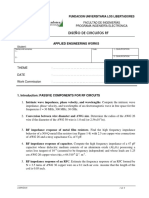History of Microwave Communication
History of Microwave Communication
Uploaded by
JessaSanchezCopyright:
Available Formats
History of Microwave Communication
History of Microwave Communication
Uploaded by
JessaSanchezOriginal Description:
Original Title
Copyright
Available Formats
Share this document
Did you find this document useful?
Is this content inappropriate?
Copyright:
Available Formats
History of Microwave Communication
History of Microwave Communication
Uploaded by
JessaSanchezCopyright:
Available Formats
Jessa May D.
Sanchez ECE4P-D
HISTORY OF MICROWAVE COMMUNICATION
James Clerk Maxwell, using his “Maxwell equations”, predicted the existence of invisible
electromagnetic waves, of which microwaves are a part, in 1865. In 1888, Heinrich Hertz became the
first to demonstrate the existence of such waves by building an apparatus that produced and detected
microwaves in the ultrahigh frequency region. Hertz recognized that the results of his experiment
validated Maxwell’s prediction, but he did not see any practical applications for these invisible waves.
Later work by others led to the invention of wireless communications, based on microwaves.
Contributors to this work included Nikola Tesla, Guglielmo Marconi, Samuel Morse, Sir William
Thomson (later Lord Kelvin), Oliver Heaviside, Lord Rayleigh, and Olive Lodge.
In 1931 a US-French consortium demonstrated an experimental microwave
relay link across the English Channel using 10 foot(3m) dishes, one of the
earliest microwave communication systems. Telephony, telegraph and
facsimile data was transmitted over the 1.7GHz beams 40 miles between
Dover, UK and Calais, France. However it could not compete with cheap
undersea cable rates, and a planned commercial system was never built.
During the 1950s the AT&T Long Lines system of microwave relay links
grew to carry the majority of US long distance telephone traffic, as well as
intercontinental television network signals. The prototype was called TDX and was tested with a
connection between New York City and Murray Hill, the location of Bell Laboratories in 1946. The
TDX system was set up between New York and Boston in 1947. Military microwave relay systems
continued to be use into the 1960s, when many of these systems were supplanted with tropospheric
scatter or communication satellite systems. Long-distance microwave rely networks were built in
many countries until the 1980s, when the technology lost its share of fixed operation to newer
technologies such as fiber-optic cable and communication satellites, which offer a lower cost per bit.
At the turn of the century, microwave radio relay systems are being used increasingly in portable
radio applications. The technology is particularly suited to this application because of lower operating
costs, a more efficient infrastructure, and provision of direct hardware access to the portable radio
operator. Practical use of microwave frequencies did not occur until the 1940s and 1950s due to a
lack of adequate sources, since the triode vacuum tube (valve) electronic oscillator used in radio
transmitters could not produce frequencies above a few hundred megahertz due to excessive
electron transit time and inter electrode capacitance, by the 1930s, the first low power microwave
vacuum tubes had been developed using new principles; the Barkhausen-Kurz tube and the split-
anode magnetron. These could generate a few watts power of frequencies up to a few gigahertz, and
were used in the first experiments in communication with microwaves.
Microwave radar became the central technology used in air traffic control, maritime navigation, anti-
aircraft defense, ballistic missile detection, and later many other uses. Rdar satellite communication
motivated the development of modern microwave antennas; the parabolic antenna (the most common
type) and etc. The ability of short waves to quickly heat materials and cook food had been
investigated in the 1930s by I.F. Mouromtseff at Westinghouse.
You might also like
- DG ChecklistDocument2 pagesDG ChecklistJayesh Barad70% (20)
- Unidrive SP - Full Parameter ListDocument14 pagesUnidrive SP - Full Parameter ListNovansyah TriNo ratings yet
- History of Wireless CommunicationDocument4 pagesHistory of Wireless CommunicationKhánh Sơn MaNo ratings yet
- Evolution of Microwave CommunicationsDocument27 pagesEvolution of Microwave CommunicationsStephany Bryan Diez Itao67% (3)
- Introduction To Telecommunication Networks: 1.1 Historic Steps in The Telecommunication EraDocument65 pagesIntroduction To Telecommunication Networks: 1.1 Historic Steps in The Telecommunication EraZemenu BelieNo ratings yet
- FM CommunicationDocument144 pagesFM CommunicationAhmed Sakr (أحمد صقر)No ratings yet
- History 1865 To The Present The 1800 S. Before The Discovery and Development of Electricity and Radio, PeopleDocument3 pagesHistory 1865 To The Present The 1800 S. Before The Discovery and Development of Electricity and Radio, PeopleJerome TeañoNo ratings yet
- Historical Setting: The Pre-Electromagnetic PastDocument5 pagesHistorical Setting: The Pre-Electromagnetic PastRandy Owen Javier CosmeNo ratings yet
- 5.2 Building TelecommunicationDocument15 pages5.2 Building TelecommunicationJohn Rhey Almojallas BenedictoNo ratings yet
- Telecommunication Industrial SkillsDocument15 pagesTelecommunication Industrial SkillsAditya KapoorNo ratings yet
- Principle of Communication G1Document132 pagesPrinciple of Communication G1Jhon Carlo FaustinoNo ratings yet
- Preface: Information TransmissionDocument71 pagesPreface: Information Transmissiondeshmukhneha679No ratings yet
- Telecommunication Is The Transmission of Messages, Over Significant Distances, For The PurposeDocument18 pagesTelecommunication Is The Transmission of Messages, Over Significant Distances, For The PurposeMayank AgarwalNo ratings yet
- Introduction To Wireless CommunicationsDocument33 pagesIntroduction To Wireless Communicationsrahul guptaNo ratings yet
- Telecom Industry: Telecom History Since 1842 Till Now .."Document38 pagesTelecom Industry: Telecom History Since 1842 Till Now .."alok19886No ratings yet
- Customer Acquisition and Retention at Bharti AirtelDocument84 pagesCustomer Acquisition and Retention at Bharti AirtelAnonymous H6vlwbNo ratings yet
- Fundamentals of Electronics CommunicatioDocument22 pagesFundamentals of Electronics CommunicatioTom CruzNo ratings yet
- History of TelecommunicationDocument21 pagesHistory of Telecommunicationdrnileshkarle5671No ratings yet
- TELECOMMUNICATIONDocument14 pagesTELECOMMUNICATIONMilind Tambe100% (1)
- 2 RadioDocument83 pages2 RadioSri MurthyNo ratings yet
- Mukesh VodafoneDocument84 pagesMukesh VodafoneRavi Kant VermaNo ratings yet
- Telecommunications EngineeringDocument5 pagesTelecommunications EngineeringSuleiman Abubakar AuduNo ratings yet
- Telegraphy: Navigation SearchDocument16 pagesTelegraphy: Navigation Searchمحمد زبيدي نور الدينNo ratings yet
- To Study The Customer Satisfaction in AirtelDocument77 pagesTo Study The Customer Satisfaction in AirtelSami Zama0% (1)
- History of Wireless CommunicationDocument9 pagesHistory of Wireless CommunicationJasorsi GhoshNo ratings yet
- Communications: Refers To The Sending, Receiving and Processing of Information Through Electronic MeansDocument90 pagesCommunications: Refers To The Sending, Receiving and Processing of Information Through Electronic MeansAngelicaNo ratings yet
- A History of Wireless Technologies: There Is Absolutely No Difference Between Radio and Wireless Except The SpellingDocument6 pagesA History of Wireless Technologies: There Is Absolutely No Difference Between Radio and Wireless Except The SpellingSudip BishwakarmaNo ratings yet
- Telegraph and Telephone HistoryDocument3 pagesTelegraph and Telephone HistoryBubacarr BahNo ratings yet
- History of Radio - WikipediaDocument18 pagesHistory of Radio - WikipediaManoj WilsonNo ratings yet
- Tomasi PDFDocument159 pagesTomasi PDFmiel_garrido82% (11)
- Lecture 1 (Complete) Intro To Wireless CommDocument94 pagesLecture 1 (Complete) Intro To Wireless CommxxxxxxxxxxxxxxxxxxxxNo ratings yet
- Telecommunications - WikipediaDocument29 pagesTelecommunications - WikipediaSebastian GhermanNo ratings yet
- Couch 01Document32 pagesCouch 01elad kotlovskiNo ratings yet
- History: Telecommunication IsDocument9 pagesHistory: Telecommunication IsswathipalaniswamyNo ratings yet
- History: Telecommunication IsDocument9 pagesHistory: Telecommunication IsswathipalaniswamyNo ratings yet
- TelecommunicationsDocument3 pagesTelecommunicationsOscar GuardadoNo ratings yet
- Wireless Networks: Book: (1st Chapter) T. S. Rappaport, Wireless Communications, 2nd Edition, PearsonDocument33 pagesWireless Networks: Book: (1st Chapter) T. S. Rappaport, Wireless Communications, 2nd Edition, PearsonMd Shamim HossainNo ratings yet
- This Article Is About The TechnologyDocument6 pagesThis Article Is About The TechnologymarkanthonypadilNo ratings yet
- Wayne Tomasi - Advanced Electronic Commun PDFDocument102 pagesWayne Tomasi - Advanced Electronic Commun PDFIan VillarojoNo ratings yet
- Cellular 1 PDFDocument9 pagesCellular 1 PDFluay anwarNo ratings yet
- Telecommunications Engineering - WikipediaDocument57 pagesTelecommunications Engineering - Wikipediaannorvictor2323No ratings yet
- Art Integrated Activity Science Class 9 - MathivananDocument27 pagesArt Integrated Activity Science Class 9 - MathivananMathivanan MathivananNo ratings yet
- Modulation Reviewer For ECEDocument171 pagesModulation Reviewer For ECEianneanNo ratings yet
- FFDFDocument26 pagesFFDFSoumava PaulNo ratings yet
- "Since Its Invention in 1876 The Telephone: Morse, Samuel Finley Breese (1791-1872), AmericanDocument7 pages"Since Its Invention in 1876 The Telephone: Morse, Samuel Finley Breese (1791-1872), AmericanSorin CosminNo ratings yet
- REVIEWER in Electronic Communications System by Wayne TomasiDocument112 pagesREVIEWER in Electronic Communications System by Wayne TomasiShe San100% (2)
- Evolution of TelecommunicationsDocument45 pagesEvolution of TelecommunicationsSai RamNo ratings yet
- 1768 Some Stories About Popular Inventions and DiscoveriesDocument100 pages1768 Some Stories About Popular Inventions and DiscoveriesSasi DivakaranNo ratings yet
- Benefits of Standards in ComputingDocument14 pagesBenefits of Standards in ComputingUriahs VictorNo ratings yet
- Waves - Properties and Uses: Section 3Document29 pagesWaves - Properties and Uses: Section 3raj bhutiyaNo ratings yet
- History of Mobile and Wireless CommunicationDocument7 pagesHistory of Mobile and Wireless CommunicationMaria IramNo ratings yet
- TelecommunicationDocument6 pagesTelecommunicationkarthiveera100% (1)
- Introduction To Electronic Communications: # Definitions TermsDocument16 pagesIntroduction To Electronic Communications: # Definitions Termstsk2230No ratings yet
- Basic of TelecommunicationsDocument25 pagesBasic of TelecommunicationsClaren daleNo ratings yet
- Comminication System - Analog and DigitalDocument79 pagesComminication System - Analog and DigitalDfm-Crisna RadityaNo ratings yet
- Cellular Mobile Communication March2021Document80 pagesCellular Mobile Communication March2021Snehapriya SAllyNo ratings yet
- TelecommunicationDocument9 pagesTelecommunicationNanee DevaNo ratings yet
- Eti 2504: Wireless Communication 1: Lecturer: Mrs. Onyango Class: Year 5 Semester 1 24 May 2024Document35 pagesEti 2504: Wireless Communication 1: Lecturer: Mrs. Onyango Class: Year 5 Semester 1 24 May 2024Eucabeth AchiengNo ratings yet
- Wireless World : The Earth With Electronic Waves Around UsFrom EverandWireless World : The Earth With Electronic Waves Around UsRating: 5 out of 5 stars5/5 (1)
- Wire Loop Game: (Using Arduino Mega)Document6 pagesWire Loop Game: (Using Arduino Mega)JessaSanchezNo ratings yet
- What Are You Feeling Right Now?Document13 pagesWhat Are You Feeling Right Now?JessaSanchezNo ratings yet
- Material Safety Data SheetDocument29 pagesMaterial Safety Data SheetJessaSanchezNo ratings yet
- Light Sensor/Detector IN (Fixed Bias Circuit) : Technological University of The Philippines VisayasDocument4 pagesLight Sensor/Detector IN (Fixed Bias Circuit) : Technological University of The Philippines VisayasJessaSanchezNo ratings yet
- elo4NL7WB66 DDocument8 pageselo4NL7WB66 DFrancisco SantanaNo ratings yet
- Funai 32fl553p.10 32fl553.10 Service ManualDocument42 pagesFunai 32fl553p.10 32fl553.10 Service ManualAchim F.No ratings yet
- Power Monitoring Solutions Metering Products: PricelistDocument31 pagesPower Monitoring Solutions Metering Products: PricelistpmyilsamyNo ratings yet
- Ca 3260Document4 pagesCa 3260Carlos TibussiNo ratings yet
- Common Wire Splices & JointsDocument29 pagesCommon Wire Splices & JointsJama Casay100% (1)
- Defective Ground Structure Microstrip Patch Antenna For ISM, Wi-MAX and C-Band Using U Slotted StructureDocument8 pagesDefective Ground Structure Microstrip Patch Antenna For ISM, Wi-MAX and C-Band Using U Slotted StructureIJAFRCNo ratings yet
- Lab 6Document5 pagesLab 6par1vej2100% (1)
- 8.6 MV Feeder Earth-Fault ProtectionDocument20 pages8.6 MV Feeder Earth-Fault Protectionbiviana81No ratings yet
- Detailed Lesson Plain in Grade 2 - Science Day 7...Document3 pagesDetailed Lesson Plain in Grade 2 - Science Day 7...Nyca PacisNo ratings yet
- Electrical AccessoriessDocument47 pagesElectrical Accessoriesssudiro100% (1)
- Capacitor Switching Techniques: AbstractDocument4 pagesCapacitor Switching Techniques: AbstractMostafa MohmmedNo ratings yet
- CST Tutorial MicrostripDocument23 pagesCST Tutorial MicrostripTfNo ratings yet
- EDH Engineering GuideDocument3 pagesEDH Engineering GuideDo MinhNo ratings yet
- Cyaby (F), Cyabzy (F), VavDocument4 pagesCyaby (F), Cyabzy (F), Vavstupard1989No ratings yet
- TD SYSTEMS ALL COMBINED 2-Made by AfaqDocument39 pagesTD SYSTEMS ALL COMBINED 2-Made by Afaqabdul masudNo ratings yet
- Process Control: Cement Process Engineering Vade-MecumDocument9 pagesProcess Control: Cement Process Engineering Vade-MecumHasnaoui SamirNo ratings yet
- Type P8n, PQ8n, PN8n: Auxiliary RelayDocument7 pagesType P8n, PQ8n, PN8n: Auxiliary RelayAmit KumarNo ratings yet
- A510 Instruction Manual PDFDocument459 pagesA510 Instruction Manual PDFPhops FrealNo ratings yet
- Casio CTK530 ServiceDocument18 pagesCasio CTK530 ServiceAdilson SouzaNo ratings yet
- IEEE Power System Paper-A 20-KW, 10-KHz, Single-Phase Multilevel ActiveDocument7 pagesIEEE Power System Paper-A 20-KW, 10-KHz, Single-Phase Multilevel ActiveAnoop MathewNo ratings yet
- Introduction To CommutationDocument45 pagesIntroduction To CommutationSobi67% (3)
- Chapter 9 - InductionDocument11 pagesChapter 9 - InductionLin ChongNo ratings yet
- Suction Unit Askir36br User ManualDocument11 pagesSuction Unit Askir36br User ManualAbdolkader NajebNo ratings yet
- Absolyte Engineering PDFDocument110 pagesAbsolyte Engineering PDFwizlishNo ratings yet
- Pertemuan Ke 7 - Bab 3-16-26Document11 pagesPertemuan Ke 7 - Bab 3-16-26Lelouch ViNo ratings yet
- Diseño de Circuitos RF: Applied Engineering WorksDocument4 pagesDiseño de Circuitos RF: Applied Engineering WorksJose Romero MurilloNo ratings yet
- AC Machine Lecture No6Document43 pagesAC Machine Lecture No6Mohammed Dyhia AliNo ratings yet
- Eat - Eglos Hifi News 2017Document1 pageEat - Eglos Hifi News 2017quad111No ratings yet





























































































